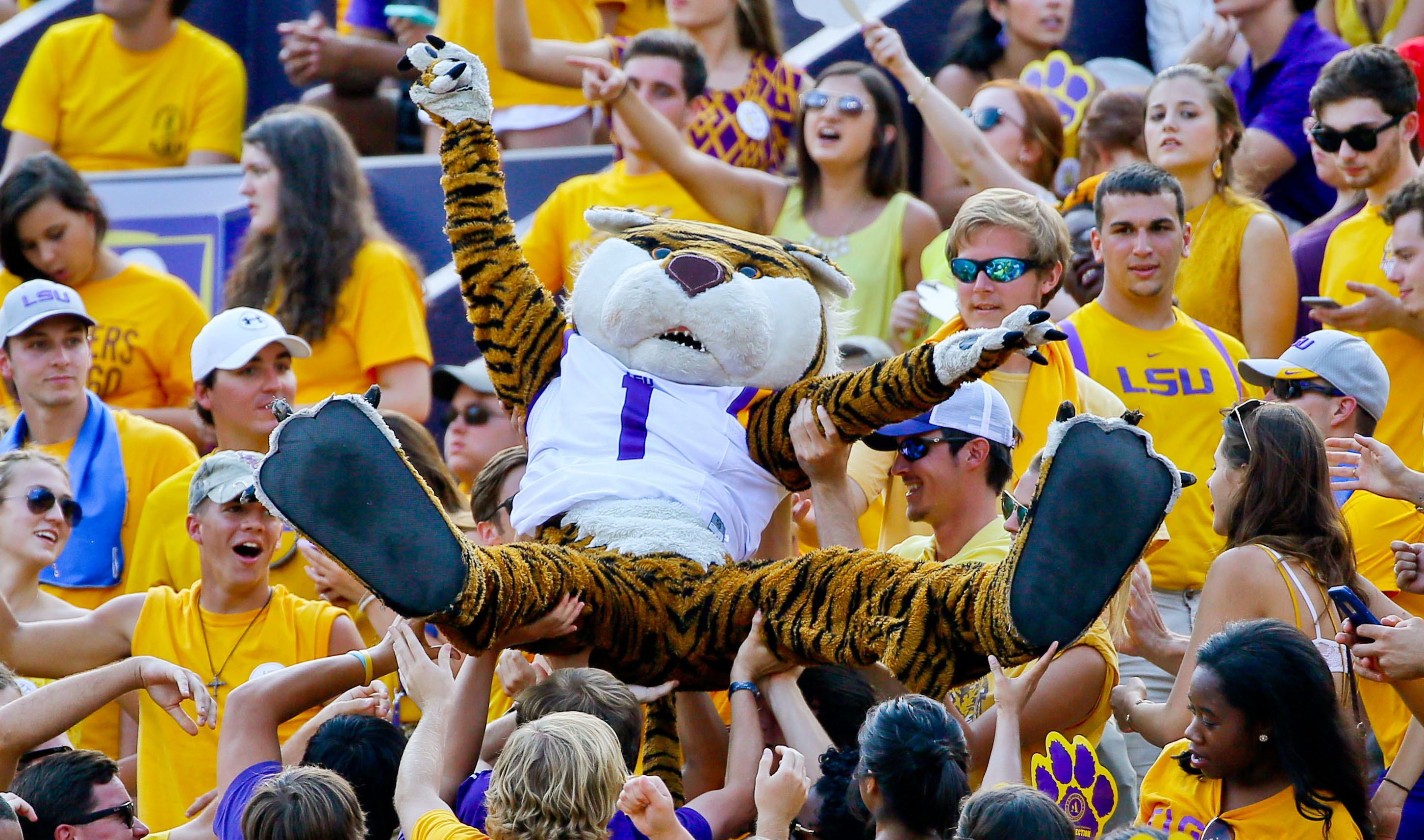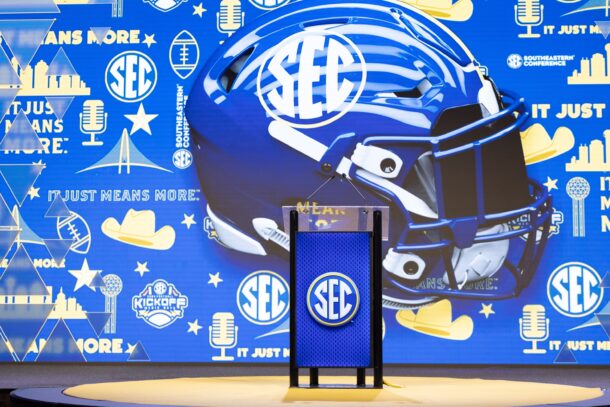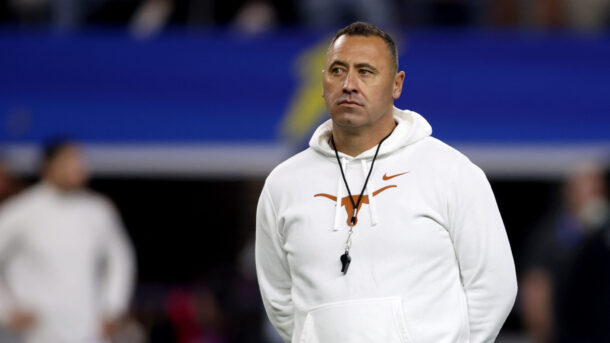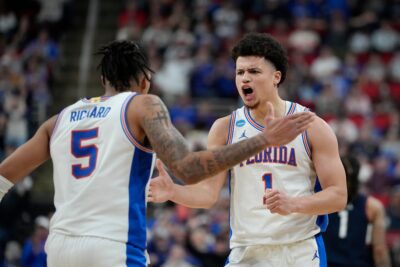Ad Disclosure

The world of the anthropomorphic has a rich history in the SEC. The conference is home to some of the most-iconic animals and people celebrated in mascot form.
Here is a look at the SEC’s mascots and a brief history of how each came about.
ALABAMA CRIMSON TIDE
Mascot: Big Al
Origin date: 1930
Like many college teams, Alabama earned their original nickname via the sports reporters of the day. In The case of Crimson Tide’s pachyderm, the moniker “Red Elephant” was associated with the team after sports writer Everett Strupper coined the term in a 1930-piece that ran in the Atlanta Journal.
To wit:
“At the end of the quarter, the earth started to tremble, there was a distant rumble that continued to grow. Some excited fan in the stands bellowed, ‘Hold your horses, the elephants are coming,’ and out stamped this Alabama varsity.”
Big Al, the costumed mascot was designed and created by Brooks Van Horn Costumes — who also constructed mascots for Disney — and made his debut at the 1980 Sugar Bowl.
ARKANSAS RAZORBACKS
Mascot: Tusk
Origin date: 1909
Georgia isn’t the only school whose live mascot hails from a long lineage. Arkansas’ “Tusk IV” comes from a familial line of swine mascots in Fayetteville. The Russian boar has been a campus staple since the school eschewed its old cardinal mascot in 1909. The move came after head coach Hugo Bezdek proclaimed that his squad played like a “wild band of razorback hogs.” The name stuck and in the 1960s Arkansas officially unveiled the live mascot version. The live hog has had a colorful history on the Hill. Big Red III, for example, was killed in 1977 by a farmer who didn’t take to kindly to the havoc the escaped animal was wreaking upon his land.
AUBURN TIGERS
Mascot: Aubie
Origin date: 1892
Auburn has been known as the Tigers dating back to 1892. But Aubie didn’t make his debut until 1959, doing so as an animated figure on the Oct. 3 on the program cover for the Tigers’ contest with Hardin-Simmons — a game that Auburn won 35-12. Eventually Aubie began walking upright and put on some clothes. In 1979, the school unveiled the costumed-version of Aubie. As for the “Tigers” nickname, that derives from an Oliver Goldsmith poem entitled “Deserted Village.”
“Where at each step the stranger fears to wake
The rattling terrors of the vengeful snake;
Where crouching tigers wait their hapless prey,
And savage men, more murderous still than they.”
FLORIDA GATORS
Mascot: Albert
Origin date: 1908
The alligator was a natural choice in 1908 when local Gainesville merchant Phillip Miller and his son Austin set out to create a mascot for the then-mascot-less University of Florida. Up until then, the school was simply known as the “orange and blue.” The students fell in love with the Gator name and adopted a live animal starting in the 1957 season. Not everyone loved the live alligator, however, as tales of mistreatment, abuse and kidnapping (yes, Florida State fans had the cojones to swipe an alligator), became the stuff of folklore. Eventually the live gator was swapped out for the cuddlier costume versions of Albert and Alberta, who received new, lighter duds for the 2015 school year.
GEORGIA BULLDOGS
Mascot: Uga
Origin Date: 1894
One of the more recognizable mascots in college football, the pure white English bulldog has been the slobbering-face of Georgia football since 1894 when the school decided that its goat wasn’t the most-intimidating mascot to bring to games. Trilby was the first bulldog mascot, followed by Mr. Angel, Butch and Mike, before the original UGA debuted between the Hedges in 1956. UGA’s descendants are still representing the school, including the current UGA X, who took his rightful throne during the 2015 season. Georgia unveiled its costumed mascot “Hairy Dawg” at the 1981 Sugar Bowl.
https://twitter.com/BFrazierUGA/status/712687272232099840
KENTUCKY WILDCATS
Mascot: Scratch
Origin Date: 1909
What’s more difficult than navigating a busy crowd in a mascot costume? Navigating a stadium in a mascot costume and on stilts. Kentucky asked its mascot to do just that when introducing the new Wildcat mascot in 1980. He joined kid-friendly “Scratch” mascot, which debuted in 1976. Kentucky earned its reputation in 1909 after Commandant Carbusier suggested the team “fought like Wildcats” during their victory over Illinois.
LSU TIGERS
Mascot: Mike
Origin Date: 1896
If Mike the Tiger is roaring, so, too, are LSU fans. Arguably the most ferocious live mascot in all of college football, Mike the Tiger has been the mascot in Death Valley since the early 1930s. Sitting outside the visiting locker rooms, Mike is as imposing a force as there is in the mascot kingdom. The original Mike I was purchased from the Little Rock Zoo and cost $750, which was raised by collecting a quarter from each student in 1934. The school is on its sixth version of the Bengal tiger, the most current version taking up residence in Baton Rouge in 2007. LSU, led by school dean and football coach Charles E. Coates Jr., decided to call itself the Tigers during the late 19th century in homage to the moniker bestowed upon Civil War fighters from Louisiana.
Oh you know… Just Mike with the assist on that home court advantage last night for @lsubasketball ? #GeauxTigers pic.twitter.com/GKCJe53XZ6
— Mike the Tiger (@LSUmiketiger) January 27, 2016
MISSISSIPPI STATE BULLDOGS
Mascot: Bully
Origin Date: 1935
Starting with “Ptolemy” in 1935, the Mississippi State sidelines has been home to English bulldogs mascots. Retroactively renamed “Bully I,” the football team has rallied behind 24 versions of the live mascot, including the current Bully XXI, who took over duties in 2015. Up until Ptolemy, Mississippi State had been loosely known as the Maroon and or the Aggies, given its A&M status — as well as the Bulldogs. That changed when Mississippi State earned university designation in 1961. In the process, the school official adopted “bulldogs” as their teams’ name.
A few years later, Mississippi State rolled out the costumed version of Bully. The mascot was infamously involved in an accident, when an ESPN cart struck the mascot, breaking the leg of the student inside the fuzzy suit.
MISSOURI TIGERS
Mascot: Truman
Origin Date: 1894
Missouri’s mascot wasn’t always known as “Truman.” The school renamed the tiger mascot after United States President Harry S. Truman after a student vote in 1984. The new cat replaced the plain gray version that was notorious for its lewd acts during games. The Tiger name derives from a civilian militia in Missouri known as the “Fighting Tigers of Columbia,” who successfully thwarted a Confederate attack during the Civil War.
OLE MISS REBELS
Mascot: Rebel Black Bear
Origin Date: 2010
“It’s a trap!” Admiral Ackbar’s famous battle cry almost became a campus tradition at Ole Miss, after the fictional Star War character gained serious traction in 2010 as the school’s newest mascot. The student-campaign to replace Colonel Reb, who was run out of town on the politically correct train in 2003, didn’t explode like a Death Star, rather fizzling in lieu of Ole Miss’ decision to go with Rebel Black Bear as the fuzzy face of its sports programs. It should be noted that, while the new mascot is a Louisiana black bear, it’s indigenous to the state of Mississippi, despite its name.
@TylerDawgden Admiral Ackbar (@olemiss_ackbar) would have made a MUCH finer mascot in Oxford! pic.twitter.com/HkVFUnTTye
— GATA Dawgs (@BassinDawg) December 30, 2013
SOUTH CAROLINA GAMECOCKS
Mascot: Sir Big Spur
Origin Date: 1900
General Thomas Sumter might have been known as the original “Fighting Gamecock,” but his feathered counterpart might wear the moniker better. That would South Carolina mascot Sir Big Spur, the Old English black-breasted red gamecock that intimidates opponents on Saturday with its ear-splitting war cry. The school is on Sir Big Spur IV, although his replacement is already being groomed. The rooster first became a campus icon two decades ago. Owners Robert Albertelli and wife Mary Snelling originally wanted to name the bird “Cock-a-Doodle-Lou” after South Carolina head coach Lou Holtz, but eventually settled on Sir Big Spur. South Carolina’s costumed-mascot “Cocky,” got his start as the cheerleader for the school’s women’s tennis team. Eventually, the rest of the athletic department warmed to Cocky and now it’s an institution at Gamecock contests.
TENNESSEE VOLUNTEERS
Mascot: Smokey
Origin Date: 1953
Legend has it that Tennessee’s original live mascot “Smokey” earned his spot after bellowing his signature bark during a contest in 1953 to crown the school’s first mascot. Reverend W.C. Bill Brooks’ “Blue Smokey” won the contest held in Neyland Stadium at halftime of the Vols game with Mississippi State, setting up a lineage of blue tick coonhound mascots that continues to this day. Smokey X took over top duties in 2013 and is the first live mascot not descendent from the original Smokey I.
A new member was added to his pack in the early 1980s with the introduction of the costumed-version of Smokey.
Tennessee's Smokey (@UTSmokey_00) Named Best Live Mascot In All Of College Football: http://t.co/Pnaa6ZfEv0 #GoVols pic.twitter.com/xrXBr12xCU
— Tennessee Fan Base (@VolsFanBASE) July 3, 2015
TEXAS A&M AGGIES
Mascot: Reveille
Origin Date: 1931
Miss Rev found her Texas A&M home in rather dubious fashion after cadets returning home from a party in 1931 accidentally struck the stray dog with their car. Known for her caterwauling at the school’s morning bugle call, the nickname “Reveille” easily stuck. The rough collie has become the Aggies’ endearing symbol and is now going on its ninth version in College Station. Fans wishing to pay their respects to the previous Reveilles can find them buried in the cemetery outside Kyle Field.
VANDERBILT COMMODORES
Mascot: Mr. C
Origin Date: 1872
Mr. C has the distinction of being the SEC’s oldest mascot, dating to 1872. Although not a naval man by trade, Mr. C, aka Cornelius Vanderbilt is the face of the Vanderbilt Commodores. A steamboat entrepreneur and railroad magnate, Commodore Vanderbilt is regarded as the founder of the school, thanks to a large monetary gift. The university immortalized the commodore with Mr. C, a big-headed costumed version of the philanthropist and one of the richest men in United State history. Of course, the costumed mascot isn’t quite as graceful as his namesake.
Chris Wuensch is a contributing writer for Saturday Down South. He covers South Carolina and Tennessee.




